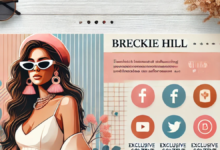How to Become a Model: A Step-by-Step Guide

Becoming a model is a dream for many, whether you’re inspired by the glamorous world of fashion, intrigued by the idea of self-expression through photography, or simply passionate about beauty and style. The journey to becoming a successful model involves much more than just good looks – it requires dedication, hard work, strategic thinking, and an understanding of the industry.
In this guide, we’ll explore the essential steps to becoming a model, including how to build your portfolio, network in the industry, maintain your physique, and handle the business side of modeling. No matter where you’re starting from, the path to modeling success begins with taking informed and deliberate steps.
Understanding the Modeling Industry
Before diving into the practical steps of how to become a model, it’s crucial to understand the modeling industry itself. The modeling world is vast and diverse, offering a range of opportunities and niches. Not all models fit the same mold, and the types of modeling are wide-ranging.
Types of Modeling
how to become a model There are many different types of modeling, each with its own set of requirements and focus. Some of the most popular categories include:
- Fashion Modeling: This is the most iconic form of modeling, often associated with runway shows, designer campaigns, and high-fashion magazines. Fashion models typically have height and body proportions that align with the industry standards, but these can vary depending on the type of fashion work.
- Commercial Modeling: Commercial models are the ones you see in advertisements for products, services, or magazines aimed at a broader audience. These models often represent a more relatable image than high-fashion models and are seen in a wide range of media, including billboards, TV ads, and online campaigns.
- Plus-Size Modeling: Plus-size models are increasingly popular and represent a body type that’s different from the traditional “size-zero” fashion model. These models often work with brands focusing on body positivity and inclusivity.
- Fitness Modeling: Fitness models are individuals with athletic and toned physiques, often featured in advertisements for gym equipment, athletic wear, supplements, or fitness-related services.
- Petite Modeling: Petite models are typically shorter than the standard runway model, usually under 5’5″. These models often appear in commercial or print advertisements rather than on runways, but their unique stature offers opportunities in the industry.
Understanding the niche you want to pursue will help guide your journey and set realistic expectations. Each modeling category has its own set of requirements,how to become a model both in terms of physicality and personality.
Modeling Agencies and Freelancing
While working with an agency offers guidance, bookings, and industry connections, some models choose to work as freelancers. Agencies generally help models find jobs, negotiate contracts, and protect their interests. However, freelancing requires more personal initiative but offers greater flexibility.
Choosing the right path depends on your personality, goals, and approach to the industry. Some models start freelancing and later sign with agencies once they’ve built their portfolio and experience.how to become a model
The Modeling Business
Modeling is a business, and understanding its business side is crucial. It involves contracts, negotiations, self-promotion,how to become a model and networking. Successful models not only have the right look but also possess the ability to manage their careers like a business. You’ll need to learn how to market yourself, manage your finances, and build strong professional relationships.
Building Your Portfolio
The first step in launching your modeling career is to create a strong portfolio. Your portfolio is your visual resume, showcasing your best work and versatility as a model. Whether you’re seeking to sign with an agency or pursue freelance modeling, a professional portfolio is essential.
What is a Modeling Portfolio?
A modeling portfolio is a collection of photographs that demonstrate your range as a model. It’s the first thing agencies, photographers, and potential clients will review when considering you for a job. Your portfolio needs to reflect your style, personality, and ability to work in different modeling categories.
Types of Photos for Your Portfolio
A good portfolio should contain a variety of photos, including:
- Headshots: These are close-up shots that focus on your face. Headshots are crucial because they show how you naturally look. Try to keep makeup minimal and avoid heavy filters.
- Full Body Shots: These should show your entire body, giving potential clients a good sense of your physique and proportions. Depending on your niche (commercial, fitness, etc.), you may want to have shots that highlight your body type.
- Editorial or Fashion Shots: These are high-fashion photos where you can showcase your ability to model in a more stylized, artistic setting. If you’re aiming for fashion modeling, these images are essential.
- Candid and Lifestyle Shots: These photos should capture you in real-life situations or pose in a more natural, unforced manner. These shots show clients that you can portray personality and sell a lifestyle.
Professional Photographer vs. Self-Taken Shots
For your first portfolio,how to become a model you should try to work with professional photographers who specialize in model portfolios. While self-shot photos or amateur work can sometimes be used to start, high-quality, professional images will significantly increase your chances of standing out.
Photographers who work with models regularly understand lighting, angles, and the right poses to highlight your best features. This expertise will elevate your portfolio.
How Many Photos Do You Need?
Typically, a modeling portfolio should have between 8-12 photos. The key is variety, so it’s essential to showcase different looks, outfits, and environments.how to become a model This is the best way to show your versatility, which is key to landing different types of modeling gigs.how to become a model
Building Your Online Presence
In today’s digital age, an online presence is just as important as having a physical portfolio. Social media platforms and personal websites can serve as tools to showcase your work and connect with potential clients.
Instagram and Social Media
Instagram is the most commonly used platform for models to display their work,how to become a model interact with fans, and connect with brands. Models often use Instagram as an online portfolio, posting a variety of photos and behind-the-scenes content to keep their followers engaged.
To succeed on Instagram, focus on posting high-quality content consistently. Ensure your posts reflect your brand and what you want to be known for. Use relevant hashtags to increase the visibility of your posts, and interact with your followers to build a loyal audience.
Building a Personal Website
A professional website is another great way to promote yourself. Include your bio, contact information, a selection of your best work, and links to your social media profiles. Your website serves as a digital business card, offering a central place for clients, agencies, or photographers to see more of your work and get in touch.
Digital Portfolios and Model Platforms
Some online platforms, such as Model Mayhem or The Green Agency, allow models to create digital portfolios. These platforms let you connect with photographers and industry professionals and are great for networking. Keep your profile updated and filled with your best work.
Taking Care of Your Body and Health
Modeling isn’t just about posing – it’s also about maintaining a healthy and attractive appearance. Keeping your body in optimal shape is an essential part of being a model.
Maintaining Your Physical Health
To become a model, you don’t need to have a specific body type, but it’s crucial to stay healthy and fit. Regular exercise, balanced nutrition, and adequate sleep are vital for maintaining energy levels and keeping your body in its best shape.
- Exercise: Many models follow workout routines to tone their bodies, improve posture, and stay fit. Strength training, yoga, and cardio are all great ways to stay in shape.
- Diet: A balanced diet filled with whole foods will ensure that you have the energy and stamina needed for your job. Many models work with nutritionists to ensure they’re eating the right foods for their body type and the demands of the industry.
- Skin and Hair Care: Healthy skin and hair are essential for a model. Regular skin care routines, staying hydrated, and taking good care of your hair can help you maintain a fresh and polished appearance.
Mindset and Mental Health
While physical health is important, mental health is equally crucial in the modeling industry. Rejection, the pressure to maintain certain beauty standards, and long working hours can be challenging. It’s essential to build mental resilience.
Take time to care for your emotional well-being. Practice mindfulness, engage in activities that relax and rejuvenate you, and make sure you maintain a support network of friends and family.
- Networking and Gaining Experience
Networking is a vital aspect of building a successful modeling career. Connecting with the right people can help you get your foot in the door, learn more about the industry, and find work opportunities.
Building Connections with Photographers
One of the most important connections for any aspiring model is a photographer. Working with experienced photographers will help you improve your posing and develop your portfolio. It also opens doors to more opportunities as photographers can connect you with agencies and brands.
If you’re starting, consider collaborating on test shoots (or TFP, trade for print) where you and the photographer exchange your time for photos. These shoots allow both parties to create new content for their portfolios.
Attend Modeling Events and Shows
Modeling events, runway shows, and industry parties are excellent networking opportunities. Attend local or national fashion events, and don’t be shy about introducing yourself to industry professionals. While it’s great to network online, in-person interactions can sometimes make a stronger impression.
Join Modeling Platforms
Online platforms like Model Mayhem, TheFashionSpot, and others are full of professionals who can help you network. Use these platforms to connect with photographers, stylists, and makeup artists who might be able to collaborate with you on shoots and introduce you to others in the industry.
Conclusion: Your Path to Success as a Model
Becoming a model is an exciting journey that requires more than just a good look – it’s about dedication, hard work, perseverance, and the ability to navigate the competitive landscape of the industry. Whether you choose to work with an agency or pursue a freelance career, the key to success lies in understanding the industry, building a strong portfolio, networking, maintaining a healthy lifestyle, and continuously developing your skills.





